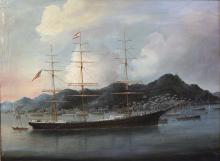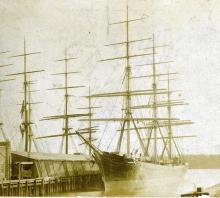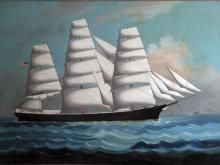Exports to Asia
In the post-Civil War years America found new goods to export to Asia. Ships carried coal, wine, beer, fish, iron, tar, chocolate, candles, steel, beef, flour, and, of course, silver dollars. Few, if any, products from Maine were exported to the Asia: by this time even lumber came mostly from the North American Pacific Coast. One exception was ice from the Kennebec River, which was carried to Calcutta, Bombay, and Batavia.
In the latter part of the 19th century, Americans exported keroseneKerosene
A mixture of liquid hydrocarbons obtained by distilling petroleum or shale, and used as a fuel., also called case oilCase oil
Kerosene packed in five-gallon cans, two cans to a wooden case. or illuminating oilIlluminating oil
Kerosene, used in lamps., to China, Japan, and India. Kerosene was first refined about 1850 from asphalt and shale extracts. After 1859 oil wells in Pennsylvania became the primary source.
Kerosene was safer and cheaper than oil as a fuel for lamps. The Standard Oil Company produced cheap lamps and small stoves that contributed to a rapidly-expanding Asian market for petroleum products, which by 1890 ranked fourth among all American exports. Kerosene was shipped in square 5-gallon tin cans, packed two to a wooden case. A large sailing ship could carry over 100,000 cases. In 1900, 19.5 million gallons of case oil were exported to Hong Kong, as well as 1.4 million barrels of wheat flour, and 3 million pounds of iron and steel. Ships also carried grain from California, mercury, lead, meats and cheeses, and cotton cloth. Despite these large numbers, trade with Hong Kong was less than 10% of the overall United States trade with China.
By the late 19th century, the value of Japanese exports to the United States exceeded that of Chinese ones.
By 1910 sail transport of case oil was dying out, as tank steamers took over.
The Bangalore is shown above loading 65,000 cases of oil for Calcutta. In the early twentieth century she was commanded by Captain Phineas Banning Blanchard of Searsport. The Belle of Bath, at right, was owned in Searsport and was destroyed by fire in 1897 while bound from New York to Hong Kong loaded with case oil.



